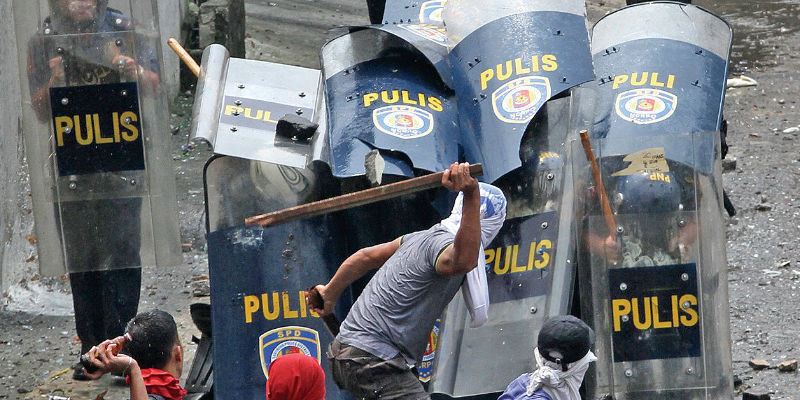
WAR ZONE Residents of Guatemala Street in San Isidro village, Makati City, clash with riot police during an attempt by a demolition crew to evict them from their homes on Monday. RICHARD A REYES
For almost four hours Monday, residents of Guatemala Street in Barangay San Isidro, Makati City, kept the police and a demolition team at bay by pelting them with rocks, bits of broken glass, molotov bombs and human waste.
As the projectiles flew, scores of people were hurt, including nine policemen from the Makati police and Southern Police District (SPD). A cameraman of RPN9, Gerardo Sabatera, suffered cuts and bruises after some of the rocks thrown by residents found their mark.
On their fourth attempt, the demolition crew and their police escorts finally succeeded in getting past the barricade put up by the illegal settlers.
Immediately after, the clearing team and a backhoe moved in and started tearing down some of the houses as a group of kibitzers broke into applause.
The residents of the 870-sq m lot had repeatedly been warned to leave the
area before the Sept. 19 deadline given by the Makati City government. The property is being eyed as the site of a P100 million barangay community complex.
At 11 a.m. Monday, a hundred men in blue shirts and hard hats hired by the city’s engineering department began to move forward to break through the barricade set up by the residents. But after several minutes, they retreated as they were met with bottles and rocks.
‘Rocks too big’
The “blue boys” later returned with the police marching behind them but
again, their efforts were thwarted by residents. “We couldn’t get past them, the rocks were too big,” Senior Superintendent Rolando Asuncion, SPD deputy director, told reporters. He added that due to the impact, some of the policemen’s shields sustained cracks.
“You saw how our policemen were wounded but still we practiced maximum tolerance to end the standoff with a minimal number of injuries,” Asuncion said.
On their third attempt to get past the barricade, a fire truck of the Makati fire department turned its water cannon on the residents but it was forced to turn back after it ran out of water.
Some, however, said that this was part of the strategy to exhaust the residents’ supply of rocks and bottles.
At a few minutes past 3 p.m., the demolition crew was back, this time accompanied by members of the Special Weapons and Tactics team who were wearing gas masks.
With a combination of tear gas and water cannons, they finally succeeded in pushing back the resisting residents and allowed the clearing team to move in.
After the situation was declared under control, Senior Superintendent Manuel Lukban, the new Makati police chief, said they arrested eight people who were believed to have instigated the violence.
“We are saddened that there are still some who refuse to move out voluntarily, although [the] majority of residents [of] Guatemala Street have agreed to avail themselves of voluntary relocation,” Joey Salgado, city information officer, said in behalf of Mayor Jejomar Erwin Binay.
He added that of the 236 families identified as residents, 137 agreed to be relocated to Calauan, Laguna, or accepted the P24,420 financial assistance offered by the city government in exchange for transferring to another area.
Based on the records of the Makati Social Welfare Department, nine of the 17 families who opted for relocation are now staying at the city-owned relocation site in Calauan while the rest are being scheduled for transfer.
On the other hand, of the 120 families who chose to avail themselves of the city government’s financial assistance, 25 have already claimed their checks. Eighteen more are set to claim their checks while the rest are waiting for their checks to be processed.
The city government, through the MSWD, has offered the informal settlers three options. These are voluntary relocation to a resettlement area in Calauan, Laguna; financial assistance of P24,240 for those who opt to relocate elsewhere; and free fare, baggage fee and three-day food assistance for those who opt to go back to their provinces.
At present, there are two relocation sites owned and managed by the city: Makati Home Ville in Barangay Dayap, Calauan, Laguna, and the GK Dreamland Ville in Barangay Kaypian in San Jose del Monte City, Bulacan.
Salgado said that the relocation sites have health centers, elementary and high school buildings, deep wells, covered courts and a multipurpose hall.